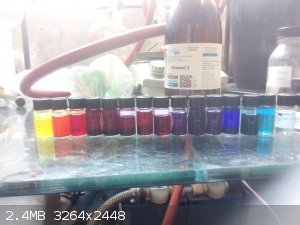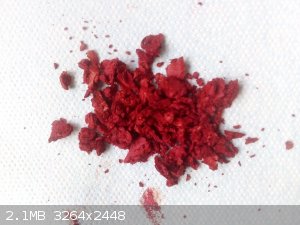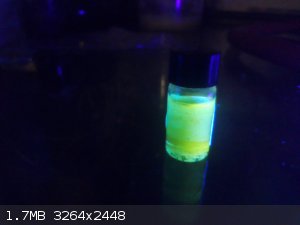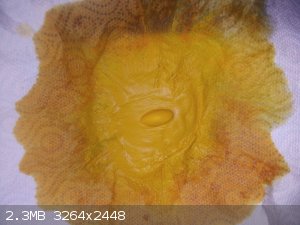Ormarion
Hazard to Self
 
Posts: 54
Registered: 19-12-2017
Location: France
Member Is Offline
Mood: Alkylating her DNA
|
|
Synthesis of Brooker's merrocyanine derivative
Hello to all of you. I wanted to share a very nice synthesis i realised some weeks ago. Some of you might be familiar with Brookers merrocyanine, a
solvatochromic molecule (changing of color depending of wich solvent it is dissolved in). It is usually made from 4 methyl pyridinium iodide and 4
hydroxybenzaldehyde and then the hydroxyle is removed using potassium hydroxyde. I worked on this molecule last year as we decided to do our school
project on it. Thanks to a friend idea from Illumina (a german chemistry forum) i decided to try using a other aldehyde, here i chosed vanilline. I
was thinking making a "greener" and cheaper approach of the procedure would be cool so..there you go.
I followed the exact protocole used for brooker's merrocyanine, the only think i modified was the 4 hydroxy benzaldehyde to vanilline, i also reduced
the reflux from 24h to 1h after the precipitation occured because for our project we saw the excess reflux was kinda useless
We begin by measuring around 1.9g of vanillin to wich we add 2.8g of 4 methyl pyridinium iodide (made from 4 picoline and methyl iodide)
To this is added a approximate amount of 30ml of dry ethanol (seem like the reaction work better in dry conditions so i also added a CaCl2 trap at the
top of the reflux)
To this mixture is added 0.1ml of piperidine, apparently pyrrolidine might work but i didn't had any under hand and i didn't wanted to use
triethylamine as yeilds are ...terribles
I then set up the reflux apparatus and let it run for a moment, a orange powder rapidly precipitated upon heating (around 20min after addition of the
piperidine), i let it reflux a hour and then let the solution cool in the freezer
We filter the product and we get a nice yellow/orange powder. At this point it is interesting to notice the same product made in the classic synthesis
is a very blood red compound and not yellow.
We then prepare around 60ml of a 1M solution of potassium hydroxyde in water and add to it the yellow powder, it immediatly take a very dark blood
color, never saw such a beautiful red in my life.
Then we slowly heat it to 80°c for around 15min and we filter hot the solution, the filtrate can be place in the fridge until a red powder
precipitate.
A this point you can filter and wash with some cold water the product (Do not wash with ethanol, it is very soluble in).
I then tried dissolving it in some solvents i had and here are the results compared to what brookers merrocyanine give
I was lazy to calculate the yeild be it seem like we might be near 90% if not more considering the amount of product i got
For the one speaking french or just wanting to look the pictures i let you acces to the project report we made on the classic brooker's merrocyanine
synth (it isn't super professional as i was a bit younger when we made it)
https://drive.google.com/file/d/1tmn2_u_z06uS-qvfazkctjFLHJ_...
First picture is the derivative in the following solvents from left to right: acetic acid, water, methanol, ethanol, isopropanol, butanol, pentanol,
hexanol, Acetone, DMSO, Acetonitrile, DMF, Pyridine, DCM, chloroform, Thiophene
We can see that compared to brookers merrocyanine the molecule dissolve very well into longer chain alcohols as well as other solvents like
dichloromethane, there is also a color switch to a more purple/pink side of the light spectrum
Second is the final product (it is still wet, i haven't dried it yet so i can't say if it have a very color changing effect like brookers merrocyanine
wich turn dark red to metallic blue)
Third pic is in cyclohexanone, surprisingly the only one with water fluorescent under UV
Last one is the intermediary product before reaction with KOH
Anyway thanks for reading me, see you next time 
 
[Edited on 6-2-2022 by Ormarion]


[Edited on 6-2-2022 by Ormarion]
|
|
|
Dr.Bob
International Hazard
    
Posts: 2656
Registered: 26-1-2011
Location: USA - NC
Member Is Offline
Mood: No Mood
|
|
Wasn't familiar with merrocyanine chemistry, but the colors are amazing. Great writup and photos.
|
|
|
Boffis
International Hazard
    
Posts: 1836
Registered: 1-5-2011
Member Is Offline
Mood: No Mood
|
|
What an interesting compound and a nice write up! And I love all of those colours. Presumably your product contains a 3-methoxy group on the quinoid
ring?
|
|
|
Ormarion
Hazard to Self
 
Posts: 54
Registered: 19-12-2017
Location: France
Member Is Offline
Mood: Alkylating her DNA
|
|
Boffis, it definitely contain one yep, thank you for the kind comment
|
|
|
SuperOxide
Hazard to Others
  
Posts: 486
Registered: 24-7-2019
Location: Devils Anus
Member Is Offline
|
|
Im glad I found this :-D I made MOED about 5 months ago, and while the precursors do smell pretty terrible (the 4-methylpyridine was the first
chemical that actually made me almost throw up, I accidentally got some on a cloth that I damn near chloroform myself on), the reaction and results
were some of the most beautiful I've had personal experience with. I couldn't, stop taking, photos.
I may give your synth a try some time. You definitely have a very detailed writeup - with photos! Thanks for that.
|
|
|
|